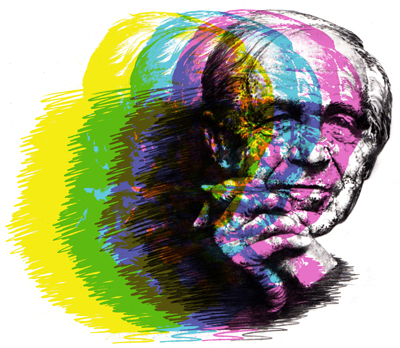by Robert Rollin

A highlight was Igor Stravinsky’s reduced arrangement of the Suite from L’Histoire du Soldat, which compresses the hour-long theatrical version into five short movements. L’Histoire was part of a series of smaller-sized works that Stravinsky composed during the devastation following World War I. No longer able to compose huge ballets, he turned the situation to his own advantage by producing a series of inventive chamber works of incredible rhythmic sophistication.
The brilliant performers were Franklin Cohen, clarinet, Mari Sato, violin, and Carolyn Warner, piano. The Soldier’s March exposed the ostinato against which the upper instruments plied their complex syncopated patterns in constantly changing metric contexts. In The Soldier’s Violin, Sato tossed off the spiccato with remarkable energy and poise. The result was extraordinary.
Cohen was excellent in the chromatic lines of the ingeniously intricate Little Concert, as Sato continued with her challenging double stops. The trio managed the Three Dances: Tango, Waltz, and Ragtime well, with Warner keeping the rhythm anchored solidly. The Devil’s Dance was equally fine, ending with a sparklingly energetic flourish.
Faculty cellist Brian Thornton’s playing was stunningly beautiful in Debussy’s Cello Sonata. The short and understated Prologue leads, after a short pause, to the animated and rapid Sérénade. Thornton’s tone quality was engaging in the long and lively Finale, and Warner played with amazing elegance and precision.
Faculty pianist Daniel Shapiro joined Warner in four short pieces by J. S. Bach, transcribed for piano four hands by György Kurtág. The first three are from Bach’s Orgelbüchlein, a collection of chorale preludes composed in Weimar. Alle Menschen mussen sterben (“All Men Must Die”) reflects Bach’s unshakeable faith. Despite the dark subject matter, it is joyous, serene, and features marvelous counterpoint.
Aus tiefer Not schrei’ ich zu dir (“Out of Deep Anguish I call to You”) moves rapidly, tone painting the supplicant’s sense of urgency. Herr Christ, der ein’ge Gottes Sohn (“Lord Christ, God’s Only Son”) includes a prominent bass line. The performances were excellent. The fourth piece was Duetto No. III in G, one of four that are appended to Bach’s German Organ Mass. It chugged along cheerfully.
The two pianists also performed Alban Berg’s Variations on Themes from “Lulu.” Hans Erich Apostel’s transcription for piano four hands seemed very dense, without the transparency of Berg’s writing.
Carolyn Warner transcribed two pieces by Ravel for violin, piano, and saxophone, and performed them on Wednesday with violinist Victor Beyen and saxophonist James Umble. Warner’s transcription of Le Tombeau de Couperin, using the same four movements that were orchestrated by the composer, shone as the first piece on the evening concert. The ensemble was excellent, and Umble’s timbre was beautiful. The evening ended with Warner’s arrangement of the Adagio from Ravel’s Piano Concerto in G, an adaptation that Boulez admired.
Graphic by Ari Michael Warner.
Published on ClevelandClassical.com October 4, 2016.
Click here for a printable copy of this article



